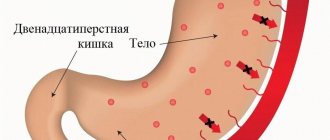Lymphocytic gastritis - the main provocateurs of the disease
Among the variety of types and forms of gastritis, there is a rare type of chronic form of the disease called lymphocytic gastritis.
This little-studied pathology is usually diagnosed in older people, most often women; children rarely suffer from the disease. A serious problem is detected during laboratory examination of the gastric mucosa. The disease itself is not so scary, but the complications it provokes result in severe stomach discomfort and can result in death.
Characteristics of lymphocytic gastritis
The pathology is an inflammatory process that affects the gastric mucosa. The main sign of a nonspecific form of the disease is considered to be pronounced lymphocytic infiltration of the epithelium (penetration of foreign particles) together with the appearance of plasma cells in the lining of the stomach.
According to doctors, the most likely causes of the appearance of characteristic signs of lymphocytic gastritis can be two main factors:
- Intolerance to gluten (celiac disease) and certain medications. Gluten is a protein found in grains, but for people with celiac disease, the protein becomes foreign. This causes gluten in the stomach to be blocked by immune killer cells, which leads to injury to the healthy cellular structures of the inner lining.
- It has been established that the gastrointestinal tract is infected with a pathogenic microorganism called Helicobacter pylori. The presence of bacteria in the surface layers of the gastric mucosa results in the fixation of characteristic changes in the structure of the epithelium, typical for the form of the disease associated with the bacterium.
Attention! Experts believe that indirect reasons for the development of lymphocytic gastritis are poor diet with a predominance of fatty and salty foods, as well as smoked, pickled, spicy and fried foods. People who abuse alcohol and smoke are at increased risk.
What symptoms indicate pathology?
A nonspecific form of dangerous pathology may not manifest itself in any way, and the sick person will not even know about the stomach problem.
Symptoms of the initial stage of lymphocytic gastritis can be manifested by the following sensations:
- Pain in the stomach area,
- The appearance of belching or heartburn,
- Nausea accompanied by vomiting,
- Bloating, flatulence,
- Constipation or diarrhea.
With a prolonged course of the disease, the pain syndrome manifests itself as cutting or cramping pain. A person loses appetite and weight, signs of iron deficiency anemia develop, and there is a risk of gastric bleeding.
If the symptoms of lymphocytic gastritis develop with increased secretion of gastric juice, the patient’s tongue becomes covered with a white coating.
In the case of gastritis that develops with low acidity, the tongue remains dry, but the patient complains of rumbling in the stomach with its distension. A likely sign is severe vomiting with blood fragments and a sour smell. With a reduced level of acid secretion, no weight loss or appetite occurs.
What happens with lymphocytic gastritis
A rare form of chronic gastric disease is characterized by a non-standard development pattern. Inflammation in the lymphoid type of pathology is not the result of a destructive process in the lining of the stomach due to irritation, but a response to the opposition of lymphocytes.
Local immunity in the stomach is responsible for lymphoid tissue, consisting of special cells, among which there are lymphocytes of varying degrees of maturity, as well as clusters of follicles.
After the penetration of leukocytes (infiltration) and a further increase in their number in the cells of the gastric epithelium, autoimmune reactions develop, which gives the right to speak of lymphoid gastritis as a separate stage of lymphocytic.
By protecting a segment of the damaged area of the stomach, lymphocytes attack inflammation, saving the body. Under the influence of provoking factors, lymphocytic follicles grow, this leads to uneven thickening of the gastric folds.
Due to impaired production of gastric juice, foci of atrophy are formed, which results in the development of benign lymphoma.
How is the primary diagnosis of pathology carried out?
When the first signs of discomfort and suspicion of gastritis appear, you should contact a specialist. A gastroenterologist deals with problems of the gastrointestinal tract.
The doctor will prescribe a series of studies and tests confirming gastritis in general or its lymphocytic variety:
- A general blood test helps identify the threat of an inflammatory process,
- Thanks to a detailed blood test, the fact of metabolic processes failures is detected,
- Stool analysis checks for the hidden presence of blood in it,
- Histological results indicate the degree of damage to cellular structures,
- By examining gastric juice, the acidity of the medium is determined.
Important! The main method for diagnosing signs of lymphocytic gastritis is fibrogastroduodenoscopy. The results of the study are the most informative; this is the main diagnostic method that allows us to establish the presence or absence of non-standard pathology.
Features of the deep diagnostic process
Lymphocytic gastritis is accompanied by an acute and chronic erosive process. According to the clinical picture, the pathology resembles the early stage of the Helicobacter pylori variety of the disease with a normal or increased level of secretory function.
To confirm gastritis of the lymphocytic type, it is necessary to differentiate it in relation to other special types of gastric pathology and exclude the following diseases.
Signs of autoimmune gastritis
Symptoms of the disease that develops after damage to the gastric mucosa include pallor of the mucosa, detection of polyps against the background of an anemic state.
The peculiarity of this form of gastritis is concomitant thyroiditis and diabetes mellitus. The cause of the mucosal disorder could be Helicobacter pylori or the consumption of rough food or stomach deformation.
Primary damage becomes a trigger for the start of an immune response, and the mucous membrane continues to be injured, but with antibodies to its own cells. These structures are responsible for the synthesis of hydrochloric acid and enzymes necessary for the absorption of vitamin B12. The lesion mainly affects the tissues of the stomach and its fundus.
The disease not only threatens the development of anemia, but also provokes rapidly developing atrophy of the mucosa, tripling the risk of cancer against the background of symptoms characteristic of chronic gastritis.
Diagnosis of erosinophilic gastritis
The pathology, similar in its characteristic symptoms to lymphocytic gastritis, is classified as an allergic type. In this case, the main feature of the disease is the pronounced severity of skin rashes, accompanied by itching.
Diagnosis of allergic gastritis is based on a blood test - the level of eosinophils is greatly increased. If an eosinophilic type of pathology is suspected without an increase in the blood count, a biopsy is necessary if a number of diffuse changes are detected along with swelling of the mucous membrane and erosions.
Important! In people with a predisposition to allergies, signs of allergic gastritis can be triggered by food allergens, medications, even parasites in the body.
Other precipitating diseases
Doctors consider tuberculosis to be the main cause of lymphocytic gastritis. The presence of the disease is indicated by the appearance of blood in the vomit.
In tuberculosis, sarcoidosis, and Crohn's disease, the stomach suffers from pathological changes, which causes the development of granulomatous gastritis, one of the signs of which is bloody vomiting. The appearance of blood indicates the formation of cracks due to an erosive process in the mucous and submucosal layer.
Treatment methods for lymphocytic gastritis
You should immediately consult a doctor if you experience discomfort in the stomach or manifestations characteristic of chronic pathology. After appropriate diagnosis and evaluation of laboratory test results, the specialist selects an individual treatment regimen for lymphocytic gastritis.
What a gastroenterologist will advise first:
- Review the food range, paying attention to the regime,
- Control body weight, avoiding obesity or wasting,
- Give up bad habits, self-medication with over-the-counter drugs,
- Follow the doctor’s recommendations, completing the treatment of lymphocytic gastritis to the end,
- Undergo regular medical examinations, not forgetting a visit to a gastroenterologist.
Principles of drug therapy
During fibrogastroscopy, the patient swallows a flexible hose of an optical probe, the end of which is equipped with a video camera. The doctor observes the results of a detailed review of the stomach cavity and its walls on the monitor screen.
The main advantage of the technique is the ability to obtain material for analysis. Based on the results of the examination and the clinical manifestations of the disease, the doctor prescribes drugs for the treatment of lymphocytic gastritis.
- Correction of gastric juice secretion, as well as blocking histamine receptors, is carried out by prescribing Famotidine, Ranitidine.
- To protect the gastric mucosa, drugs that reduce acid dependence are needed, which is achieved with the help of Omeprazole, Pariet.
- Neutralization of the aggressive effect of hydrochloric acid is carried out by drugs such as Maalox, Phosphalugel, Rennie, Almagel.
- Taking Bioagastron, Dalargin, Metacil allows you to protect the gastric mucosa from the formation of cracks and the erosive process.
- Enzymatic preparations that promote food digestion - Panzinorm, Mezim, Creon, Festal - will help regulate the functioning of the digestive tract.
- To combat bacterial flora, it is necessary to take anti-Helicobacter antibiotics - Azithromycin, Amoxiclav, Amoxicillin, Clarithromycin.
- Prescribing Domperidone, Motilium, Lactiol, Itomed will help restore motility and proper functioning of the stomach.
- The gastric lining is protected from external irritations by the drug De-nol, which has a wall-enveloping effect.
Important! Positive results from drug treatment of lymphocytic gastritis can only be expected if you consult a specialist in a timely manner. Otherwise, irreversible complications cannot be avoided; untreated ulcers of the mucous membrane lead to the formation of a cancerous tumor.
Doctors recommend combining drug therapy with phytotherapeutic methods:
- Taking herbal decoctions of chamomile, calendula, calamus root, licorice, which alleviate unpleasant symptoms,
- For gastritis with low acidity, you can brew celandine, plantain, wormwood,
- Drinking potato and cabbage juice (freshly prepared) will help restore stomach acidity.
- To eliminate stomach pain and normalize the functioning of the gastrointestinal tract, an infusion of flax seeds is prepared.
Drug therapy for lymphocytic gastritis must be supported by adherence to a strict diet that helps reduce active inflammation of the gastric tissues and accelerate the healing of erosions on the mucous membrane.
Principles of dietary nutrition
The daily diet of a patient suffering from any form of gastric disease should consist of 5-6 meals. It should be warm and enriched with vitamins, but it should be taken in small portions.
What you will have to give up:
- From sour and spicy dishes, fried and smoked foods,
- From eating spices, rich broths, fast food,
- From excessively salty and sweet dishes, marinades, baked goods,
- From eating raw vegetables and mushrooms,
- From carbonated drinks, milk, coffee, any type of alcohol.
During treatment of lymphocytic gastritis, as well as after a course of therapy, you should eat boiled or stewed food. Allowed products can be steamed or baked; it is important that their consistency is porridge-like. Solid and cold foods are excluded, they can injure the walls of the stomach.
To quickly get rid of symptoms in the epigastric zone, you cannot do without fresh air and quitting smoking.
If you experience the slightest discomfort in the gastric tract, you should rush to see a gastroenterologist.
Loading…
Source: https://spacream.ru/bolezni/gastrit/simptomy-limfoczitarnogo-gastrita-i-ego-diagnostika
Prevention
Prevention of gastritis is as follows:
- Follow your diet and nutrition regimen.
- Maintain a daily routine and rest schedule.
- Monitor the quality of food.
- Give up bad habits (drinking alcohol and smoking).
- Avoid stress and emotional overstrain.
- Exercise, walk more.
- Have a medical examination regularly (every six months).
- Promptly treat diseases of the oral cavity, gastrointestinal tract, neurological, endocrine and infectious diseases.
What pathology is lymphocytic gastritis often combined with?
Many people know that pain in the upper abdomen that occurs after eating food indicates inflammation of the gastric mucosa, gastritis. However, of the total number of people, only half were examined. Even fewer consulted a doctor and followed recommendations for treating the disease and preventing exacerbations and complications.
Due to the many different causes that cause gastritis, there are also quite a few varieties. Chronic gastritis is a dangerous disease characterized by processes of depletion or, conversely, proliferation of cells in the gastric mucosa against a background of low-grade inflammation. The danger lies in the inaction of a person with an identified pathology.
Chronic gastritis is classified in different ways, division option:
- Non-atrophic.
- Atrophic: autoimmune and multifocal.
- Special forms: lymphocytic, granulomatous, eosinophilic, hypertrophic, chemical, radiation.
There are forms that require more attention due to their low prevalence and considerable significance in the development of complications. These include lymphocytic gastritis.
Causes of the disease
The exact reasons contributing to the development of the disease have not been identified to date. There are several assumptions:
- The bacterium Helicobacter pylori, which infects the cells of the gastric mucosa with its metabolic products. With lymphocytic gastritis, changes in the mucous membrane characteristic of initial bacterial gastritis are detected.
- Another name for this form of gastritis is gastritis associated with celiac disease (gluten intolerance). Gluten is a protein found in large quantities in cereals. The body perceives the protein as foreign and turns the immune system against it. Damage occurs to the mucous membrane of the gastrointestinal tract.
According to various sources, detection rates range from 1 to 4% among all patients with complaints during endoscopic examination.
Structural features of the lesion
Lymphocytic gastritis does not manifest itself in any specific way; endoscopic examination becomes decisive in diagnosis:
- Granular accumulations similar to papillae or nodules are visualized on the gastric mucosa.
- There is swelling and thickening of the folds of the pale gastric mucosa.
- Minor erosions are common.
After a visual examination, during fibrogastroduodenoscopy it is necessary to take a small piece of mucous membrane for microscopic examination. With lymphocytic gastritis, T-lymphocytes, white blood cells responsible for recognizing and destroying foreign cells and substances, accumulate in the lining of the stomach.
A characteristic feature is the localization of gastritis: in the vast majority of cases, all parts of the stomach are affected.
Clinical manifestations
There are no specific manifestations of the pathology. All symptoms are similar to those of Helicobacter gastritis.
- The main manifestation is pain in the ileal region, which occurs on an empty stomach or an hour after eating. The nature of the pain is varied: pulling, burning, aching, cutting. More often, pain occurs when eating rough foods that irritate the gastric mucosa.
- With the development of gastritis with increased secretory function, heartburn, belching of air, and nausea occur. The tongue is covered with a white coating and is rough.
- With decreased secretory function - heaviness in the stomach, belching with an unpleasant odor, rumbling, a feeling of transfusion in the upper abdomen. The tongue is dry, the patient indicates a burning sensation, and it is easy to identify teeth marks.
- Abnormal bowel movements often occur: diarrhea alternates with constipation.
- As the condition worsens, a characteristic symptom is vomiting, which brings temporary relief.
- With a long course of the disease, the patient loses body weight with normal appetite.
Diagnostics
Timely consultation with a doctor after detecting symptoms of ill health is often recognized as the main factor in the early diagnosis of the disease.
- A general clinical blood test will not change at the initial signs of the disease, but with a long course there is a decrease in the number of red blood cells and hemoglobin, which indicates the development of anemia. Due to the chronic process, the ESR rate will increase.
- A biochemical blood test will show in detail violations of metabolic processes.
- Fibrogastroduodenoscopy with collection of material for microscopic examination.
Differential diagnosis
It is necessary to differentiate lymphocytic gastritis from other special types of gastritis.
Autoimmune gastritis
Feature – combination with thyroiditis, diabetes mellitus. It is assumed that the disease develops due to damage to the gastric mucosa by something: be it Helicobacter or rough food, overstretching of the stomach.
After the initial damage, immune mechanisms are launched, and the mucous membrane continues to be injured due to antibodies produced in the body to its own cells that produce hydrochloric acid and the enzyme that converts vitamin B12 into the absorbable form of the vitamin.
The body and fundus of the stomach are mainly affected.
The danger of the disease lies not only in the development of anemia, but also in the atrophy of the mucosa, which occurs very quickly. In patients with autoimmune pathology of the stomach, the risk of developing an oncological process is 3 times higher.
Symptoms do not differ from those of chronic gastritis.
Diagnosis is based on identifying anemia in a blood test, conducting an immunological examination with consultation with an immunologist and fibrogastroduodenoscopy.
Eosinophilic gastritis
Another name for the disease is allergic gastritis.
From this it becomes clear that the disease is typical for people with an allergic history, that is, who have a predisposition to allergies.
Often the disease develops together with skin manifestations of allergies. The cause of development is food allergens, medications, and sometimes parasites. There are no specific clinical manifestations.
In diagnostic terms, a feature of this form of gastritis is an increase in the number of eosinophils in a blood test, but this does not always happen.
During endoscopic examination, the changes detected can be twofold: either small formations similar to polyps, or diffuse changes with the development of mucosal edema, epithelial necrosis, and erosions.
Based on the results of the biopsy, the impregnation with eosinophils is determined, protecting the body from parasitic infection.
Diseases: tuberculosis, Crohn's disease, sarcoidosis
These diseases contribute to the involvement of the stomach in the pathological process. Granulomatous gastritis develops, which, unlike other forms, is accompanied by bloody vomiting. The antrum of the stomach is affected.
In many ways, the structure of granulomas and the course of the disease depend on the underlying disease. A common feature is damage to the mucous layer, both submucosal and muscular. Vomiting blood indicates the development of cracks and erosions.
Treatment of lymphocytic gastritis
All treatment methods are divided into two large groups.
Non-drug therapy
This includes following a diet and quitting smoking and drinking alcohol.
The traditional method of treatment and maintaining results after treatment will be diet therapy.
Requirements for all therapeutic diets:
- Compliance with diet.
- Diet therapy should be complete and varied.
- Control over the correct processing of products.
- Concomitant pathology should be taken into account.
- Combining the diet with other principles of a healthy active lifestyle.
Principles of nutrition for chronic gastritis:
- Do not eat foods that mechanically irritate the stomach, for example, those containing large amounts of coarse vegetable fiber.
- Minimum chemical irritation caused by acidic foods.
- Avoid exposure to very cold and hot temperatures.
If chronic gastritis is detected in remission, diet 1 is indicated, developed specifically for patients with stomach diseases. Following a diet is necessary to accelerate the healing of erosions and reduce the activity of the inflammatory process.
Meals frequently, up to 6 times, in small portions.
Foods excluded from diet 1 if:
- pain occurs or intensifies.
- secretion increases. Products include fish and meat broths and sauces; mushrooms; salted, smoked, fried foods; pickled vegetables and fruits; spices.
The products are recommended to be boiled, baked, steamed and consumed in liquid, mushy and semi-solid form. Reduce salt intake as an irritant.
Meat and fish broths are excluded; soups are recommended to be prepared with vegetables.
It is recommended to avoid baked goods, canned food, sauces, and marinades. Carbonated drinks, coffee and dairy products are contraindicated.
It is recommended to follow the diet for up to 5 months, then gradually expand the range of permitted products.
Treatment with drugs
- Medicines that suppress secretion: H2-histamine receptor blockers (ranitidine, famotidine); proton pump inhibitors (omeprazole); antacid drugs (Almagel, Maalox, Gastal).
- Medicines that protect the gastric mucosa, for example, de-nol.
- Anti-Helicobacter drugs: antibacterial drugs.
- Regulators of motility of the digestive tract.
- Enzyme preparations.
- Herbal medicine: chamomile, yarrow, string, mint.
- Physiotherapy is recommended outside of an exacerbation and after consultation with a physiotherapist.
Surgical treatment is indicated if complications develop.
Forecast
The presence of gastritis does not affect life expectancy, but the patient’s quality of life worsens. For the reason stated above, you should pay close attention to your body and, if you feel unwell, consult a doctor.
source
The term “lymphocytic gastritis” refers to a special form of pathology, the distinctive feature of which is a pronounced infiltration of the gastric epithelium.
The disease affects mainly elderly women, but also occurs in children in the first year of life.
What exactly causes its development and why it threatens men to a lesser extent is not currently known to medicine.
Lymphocytic gastritis is a rare chronic disease. It is characterized by nonspecific clinical and endoscopic signs.
This is a special type of gastritis of pathogenetic origin, in which an increased number of lymphocytes is observed on the epithelium of the gastric mucosa.
If there is no correction in the form of adequate treatment, cells of the immune system continue to grow randomly, provoking autoimmune reactions.
Source: https://geraklionmed.ru/s-kakoy-patologiey-chasto-sochetaetsya-limfotsitarnyy-gastrit/
Diagnostics
If a person is suspected of having gastritis, it is necessary to do a series of examinations.
The first is clinical. During this examination, the doctor finds out the general condition of the patient.
Next, gastroscopy is performed. An internal examination of the stomach is performed using a special device called a gastroscope. In other words, it is a probe with a camera. Thanks to this device, you can find out with maximum accuracy the nature of the disease, its location and characteristics.
A biopsy is necessary to examine fragments of the mucous layer.
Along with gastroscopy, radiography is usually prescribed. It allows you to establish an accurate diagnosis.
A general blood and stool test and tests to detect infection are mandatory.
It should be noted that this disease affects almost 70% of people. Unfortunately, most often this disease is asymptomatic and without any manifestations. That is why it is often diagnosed in the later stages.
Lymphocytic gastritis: causes, symptoms and treatment
Many people know that pain in the upper abdomen that occurs after eating food indicates inflammation of the gastric mucosa, gastritis. However, of the total number of people, only half were examined. Even fewer consulted a doctor and followed recommendations for treating the disease and preventing exacerbations and complications.
Due to the many different causes that cause gastritis, there are also quite a few varieties. Chronic gastritis is a dangerous disease characterized by processes of depletion or, conversely, proliferation of cells in the gastric mucosa against a background of low-grade inflammation. The danger lies in the inaction of a person with an identified pathology.
Chronic gastritis is classified in different ways, division option:
- Non-atrophic.
- Atrophic: autoimmune and multifocal.
- Special forms: lymphocytic, granulomatous, eosinophilic, hypertrophic, chemical, radiation.
There are forms that require more attention due to their low prevalence and considerable significance in the development of complications. These include lymphocytic gastritis.
Classification
Classifications
The generally accepted clinical classification is the Husten modification of gastritis, 1996 (Table 1) [4].
Table 1. Sydney classification system for chronic gastritis
| Type of gastritis | Etiological factors | Synonyms (former classifications) |
| Non-atrophic | Helicobacter pylori Other factors | Superficial Chronic antral Gastritis type B Hypersecretory gastritis |
| Atrophic autoimmune | Immune mechanisms | Type A gastritis Diffuse gastritis of the gastric body associated with B12-deficiency anemia and decreased secretion |
| Atrophic multifocal | Helicobacter pylori Nutritional disorders Environmental factors | Mixed gastritis type A and B |
| Special forms | ||
| Chemical | Chemical irritants: Bile (DH) NSAIDs | Reactive gastritis type C |
Reactive reflux gastritis
The description of morphological changes is supplemented by the characteristics of endoscopic categories of gastritis: · erythematous/exudative gastritis (superficial gastritis); · flat erosion; raised erosions; · hemorrhagic gastritis; · hyperplastic gastritis; · gastritis accompanied by duodenogastric reflux (DGR) - reflux gastritis. To assess the histological severity of atrophy and inflammation, a new system for assessing gastritis OLGA (Operative Link for Gastritis Assessment) is used [5].
Table 2. Classification of atrophic gastritis (OLGA 2007)
| Antrum | Body | |||
| I | II | III | ||
| Degree 0 | Grade I | Grade II | Grade II | |
| I | Grade I | Grade II | Grade II | Grade III |
| II | Grade II | Grade II | Grade III | Grade IV |
| III | Grade II | Grade III | Grade IV | Grade IV |
| Antrum | Body | |||
| I | II | III | ||
| Stage 0 | Stage I | StageII | StageII | |
| I | Stage I | StageII | StageII | StageIII |
| II | StageII | StageII | StageIII | StageIV |
| III | StageII | StageIII | StageIV | StageIV |
In each column, atrophy is shown on a four-level scale (0–3) according to the visual analogue scale of the modified Sydney Gastritis Classification System [15] . The degree of gastritis refers to the severity of the total inflammatory infiltration (neutrophilic leukocytes and mononuclear cells), and the stage refers to the severity of atrophy.
What is lymphocytic gastritis and how to treat it?
The term “lymphocytic gastritis” refers to a special form of pathology, the distinctive feature of which is a pronounced infiltration of the gastric epithelium.
The disease affects mainly elderly women, but also occurs in children in the first year of life.
What exactly causes its development and why it threatens men to a lesser extent is not currently known to medicine.
Lymphocytic gastritis is a rare chronic disease. It is characterized by nonspecific clinical and endoscopic signs.
This is a special type of gastritis of pathogenetic origin, in which an increased number of lymphocytes is observed on the epithelium of the gastric mucosa.
If there is no correction in the form of adequate treatment, cells of the immune system continue to grow randomly, provoking autoimmune reactions.
The task of the lymphocytes located inside the epithelium of the stomach is to collect and transmit to immune cells information about food entering the digestive organs. However, due to “system breakdowns” of unknown etiology, lymphocytes make mistakes and the organ’s own cells are recognized as dangerous. The consequence of this recognition is the attack of healthy tissues by immune cells and their subsequent destruction.
Gastritis of the lymphocytic (lymphofollicular) form is an inflammation in which unusual particles penetrate into the stomach tissue, causing foci of irritation, erosion and ulcers. The disease is dangerous and can cause the development of malignant neoplasms.
People who have problems with the gastrointestinal tract need to take it as a rule:
- constantly adhere to a therapeutic diet;
- to refuse from bad habits;
- avoid troubles, learn to take care of your peace of mind;
- eat small meals and only foods that combine with each other;
- do not self-medicate.
Symptoms
There are no specific signs indicating this pathology. The course of the disease in the first stages occurs secretly.
Since any inflammation of the gastric mucosa is accompanied by heaviness in the abdomen, periodic pain, bloating, heartburn or indigestion, this case is not without a characteristic picture.
However, over time, if there is no treatment, the patient’s lymph nodes enlarge, which is explained by the “participation” of immune cells in the pathological process. In most cases, low-grade body temperature is observed.
Each organism is individual, so the same disease of the digestive tract manifests itself differently in everyone. Features of tissue damage in gastritis of the lymphocytic type create favorable conditions for the development of the following unpleasant symptoms:
- weight loss due to lack of appetite;
- distortion of taste;
- heaviness in the epigastrium;
- heartburn, bloating, flatulence, belching;
- pain in the abdomen (in any area);
- hunger pains, especially in the morning.
The standard manifestation of the disease is pain (sharp, aching, dull, burning-like) in the hypochondrium, lower or upper abdomen. If such sensations are regular, and the pain worsens not only before, but also after eating, you should immediately consult a doctor.
Reasons for development
It is impossible to determine the exact causes of the disease. Today, most gastroenterologists believe that the disease develops against the background of individual intolerance to gluten, which is part of most bread and other baked goods, and cereal products.
In people suffering from lymphofollicular gastritis, the body's defenses attack this protein (gluten), considering it a health threat. Having dealt with gluten, immune cells are mistaken for the tissues of the digestive tract.
Doctors are convinced that Helicobacter pylori, which causes various pathological processes in the gastrointestinal tract, also makes its destructive contribution.
Her favorite organs are the stomach and duodenum.
With lymphocytic gastritis, lesions characteristic of this pathogenic bacterium are found in the tissues of these organs, and its presence is confirmed by the results of laboratory tests.
Doctors believe that people who abuse sweet soda, alcoholic beverages, and “junk” foods (chips, crackers, sandwiches) are at risk and can develop this type of gastritis. The list of potential victims also includes fans of fatty, spicy, fried and smoked foods.
In addition to lymphocytic, there is also plasmacytic gastritis, and also of unclear etiology. This form is characterized by the accumulation of a large number of leukocytes in the organs of the digestive tract.
The symptoms of the disease are similar to typical manifestations of chronic inflammation of the inner lining of the stomach.
Without a thorough medical examination and laboratory test results, pathology cannot be diagnosed.
Diagnostics
Diagnosis of the disease is carried out as follows:
- general and detailed blood test;
- stool test (to determine the presence of blood);
- fibrogastroduodenoscopy;
- histological analysis (determines the degree of damage to injured tissues).
Fibrogastroduodenoscopy is performed with a special flexible tube device with a microscopic video camera installed at its end. The probe helps to examine the condition of organ tissue and allows you to take samples for further microbiological research.
This procedure provides an accurate diagnosis of the type of pathological process and allows one to identify characteristic lesions: an increase in the amount of mucus in the folds, multiple small erosions, the presence of granular, papillary-like accumulations.
Description
The concept of “gastritis” unites many inflammatory and dystrophic processes of the mucous tissues of the stomach, differing in etiology and characteristics of the course of the disease. Gastritis is a polyetiological disease, the development of which is provoked by many factors: chemical, mechanical, thermal, bacterial. This disease affects both adults and children.
Gastritis is a pathological condition characterized by damage to the mucous tissues of the stomach. The disease is classified into several forms, which differ in clinical manifestations, the course of the inflammatory process and the nature of damage to the mucosa. Inflammation can develop on the surface of the epithelial layer of the mucosa or spread to all layers of the gastric wall, including the muscle layer.
Lesions of mucous tissues can be primary, and are considered as an independent disease - primary gastritis (exogenous). Secondary gastritis (endogenous) may also develop, occurring against the background of concomitant diseases. Depending on the duration and intensity of the influence of irritating factors, gastritis can be acute or chronic. In the acute form of the disease, inflammatory changes develop. In chronic cases, there is a restructuring of the organ and atrophy of the gastric mucosa.











